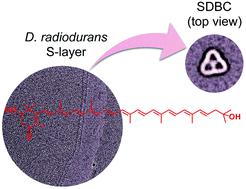当前位置:
X-MOL 学术
›
Photochem. Photobiol. Sci.
›
论文详情
Our official English website, www.x-mol.net, welcomes your feedback! (Note: you will need to create a separate account there.)
Photophysics of deinoxanthin, the keto-carotenoid bound to the main S-layer unit of Deinococcus radiodurans
Photochemical & Photobiological Sciences ( IF 3.1 ) Pub Date : 2020-03-06 , DOI: 10.1039/d0pp00031k František Adamec 1, 2, 3, 4, 5 , Domenica Farci 6, 7, 8, 9 , David Bína 2, 3, 5, 10, 11 , Radek Litvín 2, 3, 5, 10, 11 , Tuhin Khan 1, 2, 3, 4, 5 , Marcel Fuciman 1, 2, 3, 4, 5 , Dario Piano 6, 7, 8, 9, 12 , Tomáš Polívka 1, 2, 3, 4, 5
Photochemical & Photobiological Sciences ( IF 3.1 ) Pub Date : 2020-03-06 , DOI: 10.1039/d0pp00031k František Adamec 1, 2, 3, 4, 5 , Domenica Farci 6, 7, 8, 9 , David Bína 2, 3, 5, 10, 11 , Radek Litvín 2, 3, 5, 10, 11 , Tuhin Khan 1, 2, 3, 4, 5 , Marcel Fuciman 1, 2, 3, 4, 5 , Dario Piano 6, 7, 8, 9, 12 , Tomáš Polívka 1, 2, 3, 4, 5
Affiliation

|
The keto-carotenoid deinoxanthin, which occurs in the UV-resistant bacterium Deinococcus radiodurans, has been investigated by ultrafast time-resolved spectroscopy techniques. We have explored the excited-state properties of deinoxanthin in solution and bound to the S-layer Deinoxanthin Binding Complex (SDBC), a protein complex important for UV resistance and thermostability of the organism. Binding of deinoxanthin to SDBC shifts the absorption spectrum to longer wavelengths, but excited-state dynamics remain unaffected. The lifetime of the lowest excited state (S1) of isolated deinoxanthin in methanol is 2.1 ps. When bound to SDBC, the S1 lifetime is 2.4 ps, indicating essentially no alteration of the effective conjugation length upon binding. Moreover, our data show that the conformational disorder in both ground and excited states is the same for deinoxanthin in methanol and bound to SDBC. Our results thus suggest a rather loosely bound carotenoid in SDBC, making it very distinct from other carotenoid-binding proteins such as Orange Carotenoid Protein (OCP) or crustacyanin, both of which significantly restrain the carotenoid at the binding site. Three deinoxanthin analogs were found to bind the SDBC, suggesting a non-selective binding site of deinoxanthin in SDBC.
中文翻译:

Deinoxanthin的光物理性质,deinoxanthin是束缚于Deinococcus radiodurans主要S层单元的酮类胡萝卜素
已经通过超快时间分辨光谱技术研究了在抗紫外线细菌Deinococcus radiodurans中出现的酮类胡萝卜素去黄嘌呤。我们已经研究了脱黄嘌呤在溶液中的激发态性质,并与S层脱黄嘌呤结合复合物(SDBC)结合,该复合物对生物体的抗紫外线性和热稳定性很重要。脱黄嘌呤与SDBC的结合将吸收光谱移至更长的波长,但激发态动力学仍然不受影响。分离出的脱氧黄嘌呤在甲醇中的最低激发态(S 1)的寿命为2.1 ps。当绑定到SDBC时,S 1寿命为2.4ps,表明结合后有效缀合长度基本没有改变。此外,我们的数据表明,在甲醇中的脱黄嘌呤并结合到SDBC时,基态和激发态的构象障碍均相同。因此,我们的结果表明SDBC中的类胡萝卜素结合较松散,使其与其他类胡萝卜素结合蛋白(例如,橙色类胡萝卜素蛋白(OCP)或十字花青素)非常不同,两者均在结合位点显着抑制类胡萝卜素。发现了三种脱黄嘌呤类似物结合SDBC,表明脱黄嘌呤在SDBC中具有非选择性结合位点。
更新日期:2020-04-24
中文翻译:

Deinoxanthin的光物理性质,deinoxanthin是束缚于Deinococcus radiodurans主要S层单元的酮类胡萝卜素
已经通过超快时间分辨光谱技术研究了在抗紫外线细菌Deinococcus radiodurans中出现的酮类胡萝卜素去黄嘌呤。我们已经研究了脱黄嘌呤在溶液中的激发态性质,并与S层脱黄嘌呤结合复合物(SDBC)结合,该复合物对生物体的抗紫外线性和热稳定性很重要。脱黄嘌呤与SDBC的结合将吸收光谱移至更长的波长,但激发态动力学仍然不受影响。分离出的脱氧黄嘌呤在甲醇中的最低激发态(S 1)的寿命为2.1 ps。当绑定到SDBC时,S 1寿命为2.4ps,表明结合后有效缀合长度基本没有改变。此外,我们的数据表明,在甲醇中的脱黄嘌呤并结合到SDBC时,基态和激发态的构象障碍均相同。因此,我们的结果表明SDBC中的类胡萝卜素结合较松散,使其与其他类胡萝卜素结合蛋白(例如,橙色类胡萝卜素蛋白(OCP)或十字花青素)非常不同,两者均在结合位点显着抑制类胡萝卜素。发现了三种脱黄嘌呤类似物结合SDBC,表明脱黄嘌呤在SDBC中具有非选择性结合位点。


























 京公网安备 11010802027423号
京公网安备 11010802027423号